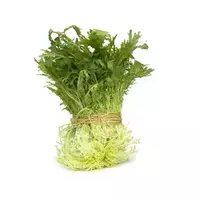Frieze salad

Frieze lettuce (frisse, curly endividium, endive, salad chicory) has been known to humanity since ancient Rome and Greece. Already in those days, people began to cultivate frieze lettuce and eat the product. It is noteworthy that the name of the frieze salad was given by the French word frisé, which means "curly. " Indeed, the appearance of the frieze salad is fully consistent with the name. The leaves of frieze lettuce are distinguished by their color, which begins green at the root and lettuce in the middle of the plant.
Frieze lettuce is a subspecies of the Endividius family. The closest relatives of the frieze salad in terms of structure and taste characteristics are white chicory, Belgian and curly chicory. The amazing thing is that frieze salad is just an improved variety of curly or curly endive. The thing is that the color of the curly endive did not appeal to the discerning French public. However, the beneficial properties of endive left no choice, and the French decided to improve the product.
The result was a frieze salad, which was previously grown according to a special method called blanching. To get a light middle of the frieze salad, the plant was bound, so the light did not enter the core, where the production of chlorophyll stopped. The leaves in the core of the frieze did not change their color and became more tender and not as bitter in taste as those of the curly endive. Currently, new varieties of frieze lettuce are bred with initially more delicate and less bitter light-colored leaves in the middle of the plant.
The size of the frieze salad is close to the head salad. Recently, frieze lettuce has been in demand and stable popularity among consumers. This is due primarily to the taste and consumer characteristics of the salad. Frieze works great with other varieties, so the product can often be found in a mix of green salads. Frieze salad gives the final dish a light mustard in flavour. It is not possible to pass by and not note the decorativeness of the frieze salad. Frieze leaves serve as a wonderful decoration and addition to meat and fish dishes.
It is believed that frieze lettuce is perfectly combined with seafood, cheeses, bacon, as well as citrus, so the plant is used in salads and snacks. In order for your dish with frieze to be tasty and useful, you need to choose the right salad, the leaves of which must be fresh and fit tightly together. Flaccid frieze leaves will only spoil the dish with their bitter taste. Salad frisé leaves are best "ripped" with your hands rather than cut. So in the final dish will be preserved more beneficial substances and vitamins, which contains salad frieze.
14 kCal frieze salad
The energy value of frieze salad (Ratio of proteins, fats, carbohydrates - ju):
Proteins: 1.5 g (~ 6 kCal)
Fats: 0 g (~ 0 kCal)
Carbohydrates: 2.2 g (~ 9 kCal)
Energy ratio (bj | y): 43% | 0% | 63%
 Español
Español Français
Français Português
Português Русский
Русский 简体中文
简体中文 繁體中文
繁體中文 日本語
日本語 한국어
한국어 العربية
العربية Türkçe
Türkçe Қазақ
Қазақ Deutsch
Deutsch Italiano
Italiano Українська
Українська
